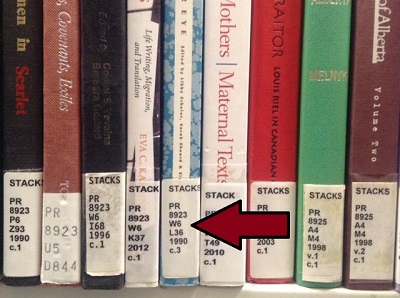How call numbers work
All print or paper copies of books in the library are assigned a call number, usually found on the book spine.
The call number represents what the book is about and acts like the book's address on the library's shelves or stacks. Because books on the shelves are arranged in call number order, you will find books on similar subjects shelved near each other.
At the SFU Library, we use the Library of Congress (LC) classification system. LC call numbers are made up of letters and numbers and look something like this:
Finding your book once you have a call number
Once you have a call number for your book (or other item), you can use the floor plan link in the book's Catalogue record to see the area of the Library where you can find the book.
Or check these SFU Library maps to find the location.
Steps for finding your call number on the shelf
- Start with finding the first letter of your call number. For the example above, call numbers starting with P are on the 5th floor of the W.A.C. Bennett Library in Burnaby.
- Call numbers beginning with a single letter come before call numbers with a second letter, e.g.: P before PA, then PB, PC, and so on until PR.
- Once you are in the correct letter area (in this example, PR), the books are in number order, e.g.: PR 8923 comes after PR 90 and before PR 9000.
- The next part of the call number is read like decimals, e.g.: PR 8914 J46 1992 comes before PR 8914 J6
- Many books also include the year of publication. In this example it is 1990. This will help you find the right edition, if there is more than one.
Using call numbers to browse the shelves
To browse a general subject area, you can start by finding the call number for a book or books on your subject, then looking at the shelves nearby.
Or you can use tools like the Library of Congress Classification Outline to get more specific subclassifications to browse, such as: BC for Logic; MT for Music Instruction and Study; QP for Physiology. (Note that these are still large categories, and depending on the size of the library where you are searching, you may be overwhelmed with results!)
Library of Congress (LC) classification system and call numbers (subject classifications)
The Library of Congress classification system divides subjects into 21 very broad categories:
A - General Works
B - Philosophy, Psychology, Religion
C – History - Civilization
D - History – General (not U.S.)
E - U.S. History
F - U.S. Local History and Latin American History
G - Geography, Anthropology, Recreation
H - Social Sciences
J - Political Science
K - Law
L - Education
M - Music
N - Fine Arts
P - Language & Literature
Q - Science
R - Medicine
S - Agriculture
T - Technology
U - Military Science
V - Naval Science
Z - Information Science

